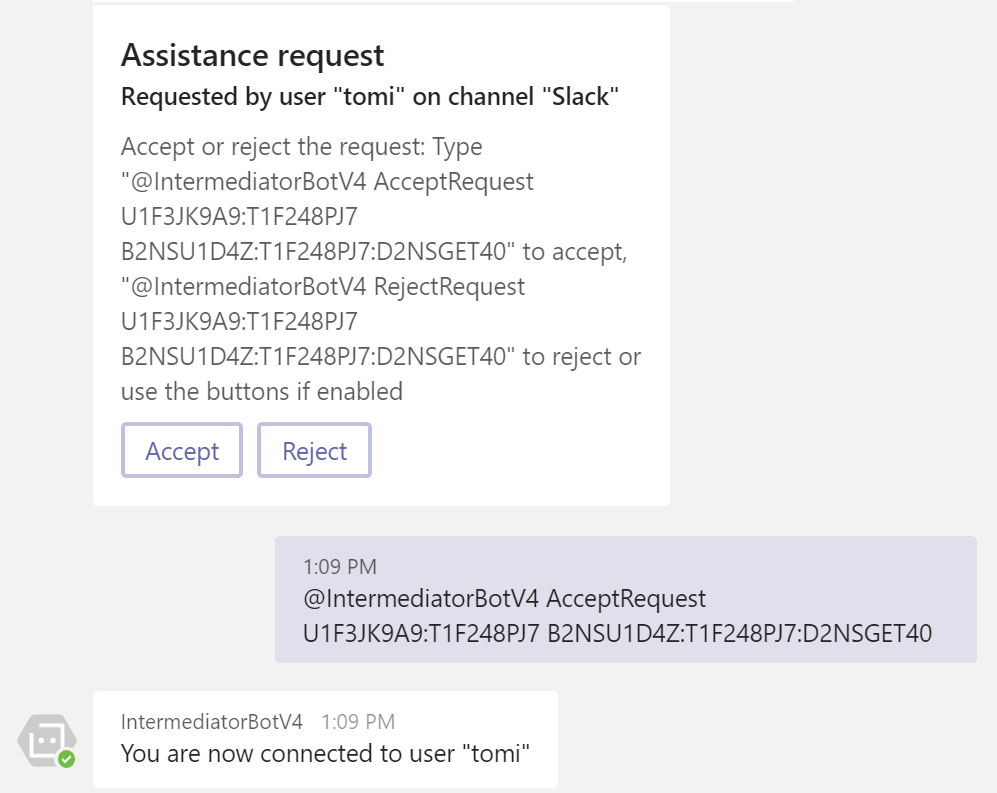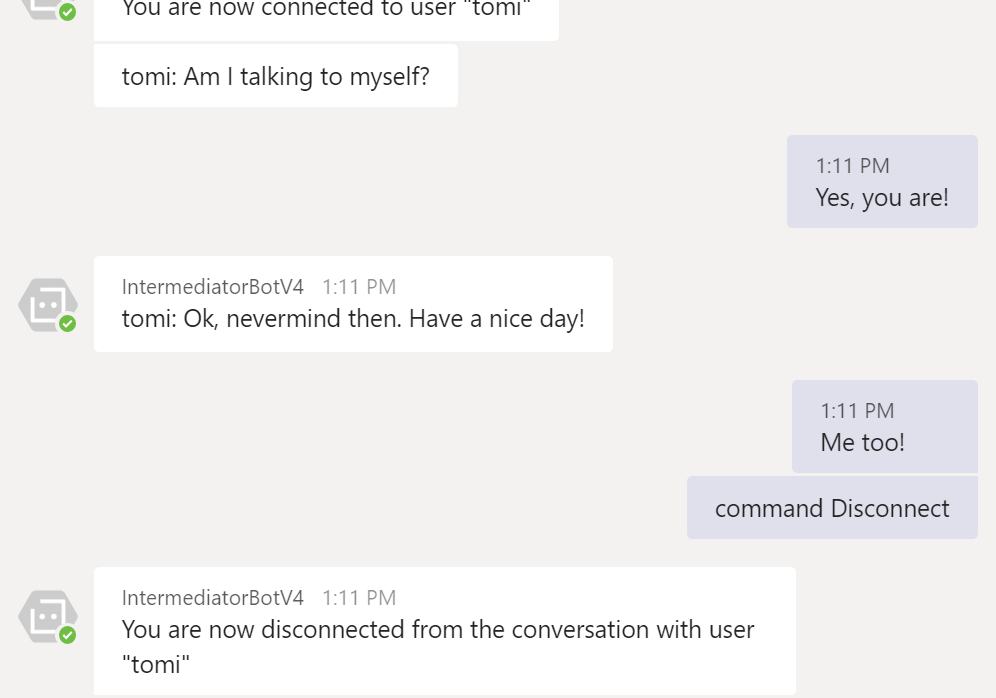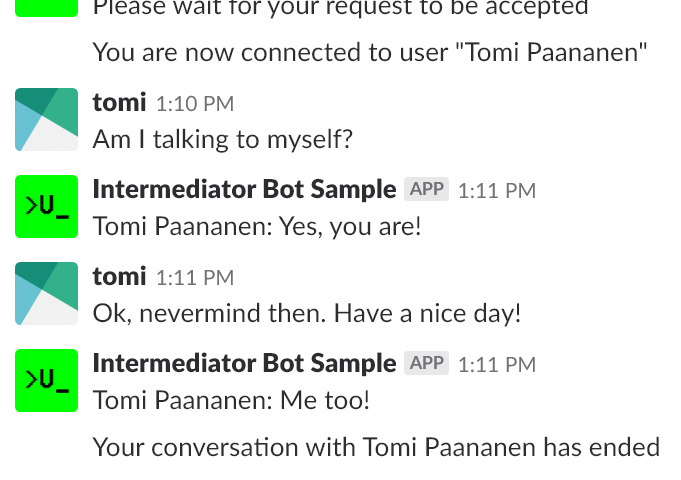tompaana / Intermediator Bot Sample
Programming Languages
Projects that are alternatives of or similar to Intermediator Bot Sample
Intermediator Bot Sample
This is a sample bot, built with the Microsoft Bot Framework (v4), that routes messages between two users on different channels. This sample utilizes the Bot Message Routing (component) project. The general gist of the message routing is explained in this article: Chatbots as Middlemen blog post.
A possible use case for this type of a bot would be a customer service scenario where the bot relays the messages between a customer and a customer service agent.
This is a C# sample targeting the latest version (v4) of the Microsoft Bot Framework. The sample did previously target the v3.x and you can find that last release here.
If you prefer Node.js, fear not, there are these two great samples to look into:
Contents
- Getting started
- Deploying the bot
- App settings and credentials
- Testing the hand-off
- About the implementation
- Custom agent portal
- Helpful links
Getting started
Since this is an advanced bot scenario, the prerequisites include that you are familiar with the basic concepts of the Microsoft Bot Framework and you know the C# programming language. Before getting started it is recommended that you have the following tools installed:
Altough the bot can be practically hosted anywhere, the deployment instructions (below) are for Azure. If you don't have an Azure subscription yet, you can get one for free here: Create your Azure free account today.
Deploying the bot
This sample demonstrates routing messages between different users on different channels. Hence, using only the emulator to test the sample may prove difficult. To utilize other channels, you must first compile and publish the bot:
- Open the solution (
IntermediatorBotSample.sln) in Visual Studio/your IDE and make sure it compiles without any errors (or warnings) - Follow the steps in this article carefully:
Deploy your bot to Azure
- Top tip: Create a new Azure resource group for the app so that if stuff goes wrong, it's really easy to just delete the whole group and start over
- Having issues testing the bot (as in "The dang thing doesn't work!!") - check the following:
- Did you remember to include
/api/messagesin the messaging endpoint (Bot Channels Registration/Settings)? - Did you remember to create and add the credentials (
MicrosoftAppIdandMicrosoftAppPassword)?
- Did you remember to include
- Add the credentials (
MicrosoftAppIdandMicrosoftAppPassword) to theappsettings.jsonfile and republish the bot - now all you need to do to republish is to right-click the app project in the Solution Explorer in Visual Studio, select Publish... and click the Publish button on the tab (named in the sample "IntermediatorBotSample").
App settings and credentials
App settings and credentials are available in the
appsettings.json
file of this sample. The file contains both bot and storage credentials as well as the settings that
can be used to tailor the experience. The default content of the file looks something like this:
{
"MicrosoftAppId": "",
"MicrosoftAppPassword": "",
"BotBasePath": "/api",
"BotMessagesPath": "/messages",
"AzureTableStorageConnectionString": "",
"RejectConnectionRequestIfNoAggregationChannel": true,
"PermittedAggregationChannels": "",
"NoDirectConversationsWithChannels": "emulator, facebook, skype, msteams, webchat"
}
Settings
-
BotBasePathandBotMessagesPathcan be used to define the messaging endpoint of the bot. The endpoint by default ishttp(s)://<bot URL>/api/messages. -
RejectConnectionRequestIfNoAggregationChanneldefines whether to reject connection requests automatically if no aggregation channel is set or not. Pretty straightforward, don't you think? -
PermittedAggregationChannelscan be used to rule out certain channels as aggregation channels. If, for instance, the list containsfacebook, the bot will refuse to set any Facebook conversation as an aggregation channel. - The solution allows the bot to try and create direct conversations with the accepted "customers".
NoDirectConversationsWithChannelsdefines the channels where the bot should not try to do this.
Credentials
-
MicrosoftAppIdandMicrosoftAppPasswordshould contain the bot's credentials, which you acquire from the Azure portal when you publish the bot. - The bot needs to have a centralized storage for routing data. When you insert a valid Azure Table
Storage connection string as the value of the
AzureTableStorageConnectionStringproperty, the storage automatically taken in use.
Testing the hand-off
This scenario utilizes an aggregation concept (see the terminology table in this document). One or more channels act as aggregated channels where the customer requests (for human assistance) are sent. The conversation owners (e.g. customer service agents) then accept or reject the requests.
Once you have published the bot, go to the channel you want to receive the requests and issue the following command to the bot (given that you haven't changed the default bot command handler or the command itself):
@<bot name> watch
In case mentions are not supported, you can also use the command keyword:
command watch
Now all the requests from another channels are forwarded to this channel. See the default flow below:
| Teams | Slack |
|---|---|
 |
|
 |
|
 |
|
 |
 |
Commands
The bot comes with a simple command handling mechanism, which supports the commands in the table below.
| Command | Description |
|---|---|
showOptions |
Displays the command options as a card with buttons (convenient!) |
Watch |
Marks the current channel as aggregation channel (where requests are sent). |
Unwatch |
Removes the current channel from the list of aggregation channels. |
GetRequests |
Lists all pending connection requests. |
AcceptRequest <user ID> |
Accepts the conversation connection request of the given user. If no user ID is entered, the bot will render a nice card with accept/reject buttons given that pending connection requests exist. |
RejectRequest <user ID> |
Rejects the conversation connection request of the given user. If no user ID is entered, the bot will render a nice card with accept/reject buttons given that pending connection requests exist. |
Disconnect |
Ends the current conversation with a user. |
To issue a command use the bot name:
@<bot name> <command> <optional parameters>
In case mentions are not supported, you can also use the command keyword:
command <command> <optional parameters>
Although not an actual command, typing human will initiate a connection request, which an agent
can then reject or accept.
Implementation
The core message routing functionality comes from the Bot Message Routing (component) project. This sample demonstrates how to use the component and provides the necessary "plumbing" such as command handling. Here are the main classes of the sample:
- HandoffMiddleware: Contains all the components (class instances) required by the hand-off and implements the main logic flow. This middleware class will check every incoming message for hand-off related actions.
- CommandHandler: Provides implementation for checking and acting on commands in messages before they are passed to a dialog etc.
-
MessageRouterResultHandler:
Handles the results of the operations executed by the
MessageRouterof the Bot Message Routing component. - ConnectionRequestHandler: Implements the main logic for accepting or rejecting connection requests.
What if I want to have a custom agent portal/channel?
Well, right now you have to implement it. There are couple of different ways to go about it. It's hard to say which one is the best, but if I were to do it, I'd propably start by...
- ...implementing a REST API endpoint (see for instance Create a Web API with ASP.NET Core). Then I'd hook the REST API into the message routing code and finally removed the text based command handling altogether.
- Another options is to use back channel messages and hook them up into the current command pipeline. Granted some changes would need to be made to separate the direct commands from the back channel ones. Also, the response would likely need to be (or recommended to be) in JSON.
- Something else - remember, it's just a web app!
